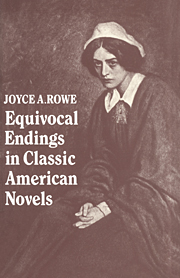 Equivocal Endings in Classic American Novels
Equivocal Endings in Classic American Novels Book contents
- Frontmatter
- Contents
- Acknowledgments
- Introduction
- 1 Nathaniel Hawthorne: “My Kinsman, Major Molineux”: The Several Voices of Independence
- 2 Bleak Dreams: Restriction and Aspiration in The Scarlet Letter
- 3 Mark Twain's Great Evasion: Adventures of Huckleberry Finn
- 4 Strether Unbound: The Selective Vision of Henry James's Ambassador
- 5 Closing the Circle: The Great Gatsby
- Conclusion: Moby-Dick and Our Problem with History
- Notes
- Index
2 - Bleak Dreams: Restriction and Aspiration in The Scarlet Letter
Published online by Cambridge University Press: 17 August 2009
- Frontmatter
- Contents
- Acknowledgments
- Introduction
- 1 Nathaniel Hawthorne: “My Kinsman, Major Molineux”: The Several Voices of Independence
- 2 Bleak Dreams: Restriction and Aspiration in The Scarlet Letter
- 3 Mark Twain's Great Evasion: Adventures of Huckleberry Finn
- 4 Strether Unbound: The Selective Vision of Henry James's Ambassador
- 5 Closing the Circle: The Great Gatsby
- Conclusion: Moby-Dick and Our Problem with History
- Notes
- Index
Summary
On a field sable, the letter a gules
Hawthorne's tale of “human frailty and sorrow” closes with this dark epitaph drawn from the tombstone that marks the lovers' double grave. The words refer to an heraldic inscription whose symbolic conjunction of red and black can be traced through the entire novel, reminding us of the power, destructive force, and inevitable limitations of human passion. The image of the tombstone itself harks back to the narrator's opening comment that “The founders of a new colony, whatever Utopia of virtue and happiness they might originally project” must of necessity allot “a portion of the virgin soil” to cemetery and prison. Thus the shape of the narrative metaphorically reinforces the awareness felt throughout the tale of crime and death as encircling conditions of human life. This awareness would seem to underscore the futility of those visionary ambitions to which the passions of all the protagonists, but especially Hester's, are allied.
The theme of the anarchic energies and dangers of human passion links The Scarlet Letter to Hawthorne's earlier story, “My Kinsman, Major Molineux.” (Even the red-black motif is anticipated in the warpaint of the devil leader in the latter.) However, in The Scarlet Letter the violence is internalized and largely self-inflicted, the rebellion generated by an act of love, not hate. Yet nothing in American literature up to this point provides as bleak a prognosis for happiness in the New World as that which Hawthorne gives us in this anatomy of the human soul. For though The Scarlet Letter is set in the historical past, it seems to me to be a profoundly contemporaneous work.
- Type
- Chapter
- Information
- Equivocal Endings in Classic American NovelsThe Scarlet Letter; Adventures of Huckleberry Finn; The Ambassadors; The Great Gatsby, pp. 27 - 45Publisher: Cambridge University PressPrint publication year: 1988
